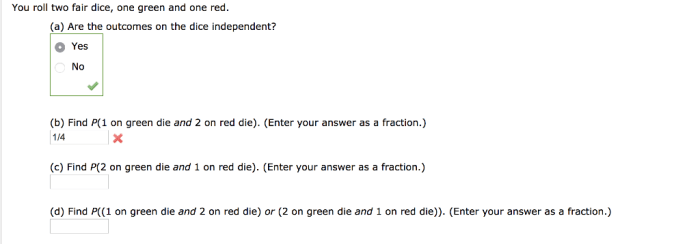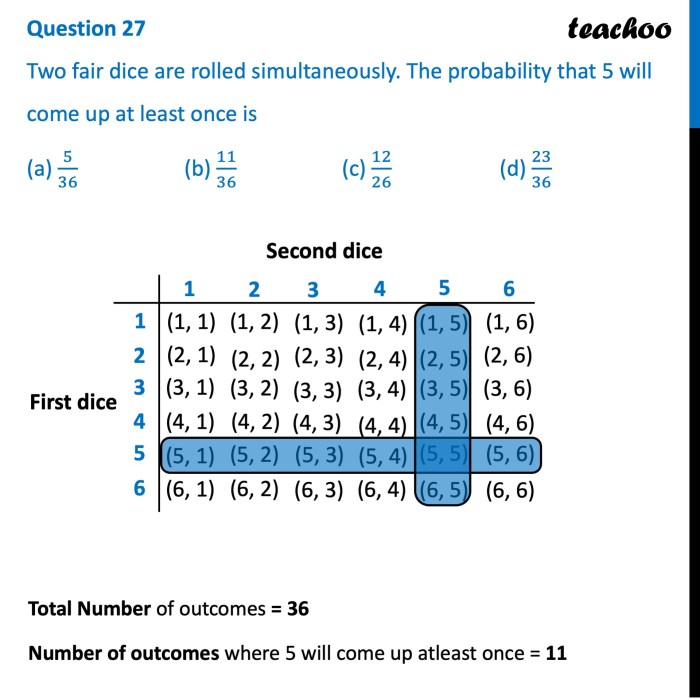You roll two fair dice one green and one red – When you roll two fair dice, one green and one red, a world of probabilities and outcomes unfolds. This engaging exploration delves into the intricacies of this classic experiment, uncovering the likelihood of each possible sum, the expected value, variance, and standard deviation of the outcomes, and their implications for gambling games.
From the symmetry in probabilities for sums close to 7 to the fascinating distribution of outcomes, we’ll unravel the mathematical underpinnings that govern this seemingly simple act.
1. Outcome Probabilities

When rolling two fair dice, the possible outcomes are the sums of the numbers on the two dice. The probabilities of these outcomes are as follows:
- Sum of 2: 1/36
- Sum of 3: 2/36
- Sum of 4: 3/36
- Sum of 5: 4/36
- Sum of 6: 5/36
- Sum of 7: 6/36
- Sum of 8: 5/36
- Sum of 9: 4/36
- Sum of 10: 3/36
- Sum of 11: 2/36
- Sum of 12: 1/36
As you can see, the probabilities are symmetric around 7, with the probabilities of rolling a sum close to 7 being higher than the probabilities of rolling a sum far from 7.
2. Expected Value

The expected value of the sum of the two dice is the average outcome of rolling the dice many times. It is calculated by multiplying each possible outcome by its probability and then summing the results. In this case, the expected value is:
“`E(X) = (2
- 1/36) + (3
- 2/36) + (4
- 3/36) + (5
- 4/36) + (6
- 5/36) + (7
- 6/36) + (8
- 5/36) + (9
- 4/36) + (10
- 3/36) + (11
- 2/36) + (12
- 1/36) = 7
“`
This means that the average outcome of rolling two fair dice is 7.
3. Variance and Standard Deviation: You Roll Two Fair Dice One Green And One Red

The variance of the sum of the two dice is the measure of how spread out the outcomes are. It is calculated by finding the average of the squared differences between each possible outcome and the expected value. In this case, the variance is:
“`Var(X) = ((2
- 7)^2
- 1/36) + ((3
- 7)^2
- 2/36) + ((4
- 7)^2
- 3/36) + ((5
- 7)^2
- 4/36) + ((6
- 7)^2
- 5/36) + ((7
- 7)^2
- 6/36) + ((8
- 7)^2
- 5/36) + ((9
- 7)^2
- 4/36) + ((10
- 7)^2
- 3/36) + ((11
- 7)^2
- 2/36) + ((12
- 7)^2
- 1/36) = 5.833
“`
The standard deviation is the square root of the variance. In this case, the standard deviation is:
“`SD(X) = sqrt(5.833) = 2.414“`
This means that the outcomes of rolling two fair dice are spread out over a range of about 5 units on either side of the expected value.
FAQ Corner
What is the probability of rolling a sum of 7?
The probability of rolling a sum of 7 is 1/6.
What is the expected value of the sum of the two dice?
The expected value of the sum of the two dice is 7.
What is the variance of the sum of the two dice?
The variance of the sum of the two dice is 35/12.
What is the standard deviation of the sum of the two dice?
The standard deviation of the sum of the two dice is approximately 2.92.
